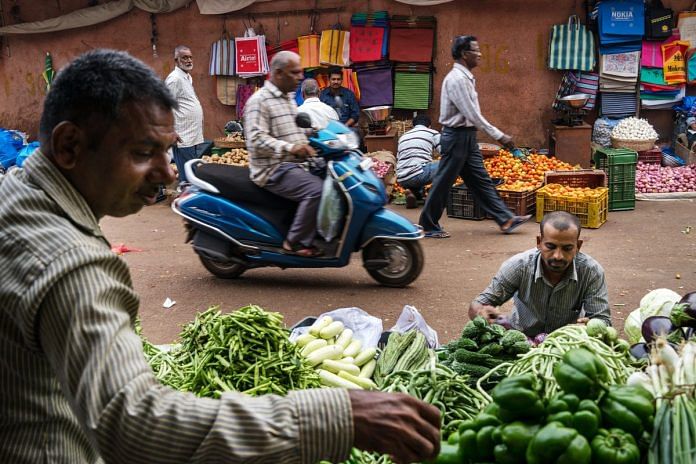New Delhi: Spiralling prices of food items, especially vegetables, pushed up the wholesale inflation to a seven-month high of 1.32 per cent in September and cements the likelihood that the Reserve Bank will continue with status quo on interest rates.
The Wholesale Price Index (WPI)-based inflation was at 0.16 per cent in August.
“The annual rate of inflation, based on monthly WPI, stood at 1.32 per cent (provisional) for the month of September, 2020 (over September, 2019) as compared to 0.33 per cent during the corresponding month of the previous year,” government data showed on Wednesday.
The WPI-based inflation appears to be moving in sync with CPI-based retail inflation which shot up to an eight-month high of 7.34 per cent in September, mainly on account of rising prices of food items.
Although the RBI takes into account retail inflation while deciding the monetary policy stance, ICRA’s principal economist Aditi Nayar said, “today’s data (on WPI inflation) further cements the likelihood of an extended pause from the Monetary Policy Committee (MPC).”
Before recording an increase of 0.16 per cent in August, the WPI inflation was in the negative territory for four straight months — April (-) 1.57 per cent, May (-) 3.37 per cent, June (-) 1.81 per cent and July (-) 0.25 per cent.
Inflation in food articles during September was at 8.17 per cent, as against 3.84 per cent in August, showed the data from the commerce and industry ministry.
Vegetables as a category had inflation of 36.54 per cent in September, potato price skyrocketed by 107.63 per cent from a year-ago period. However, onions had deflation at 31.64 per cent and in fruits, the inflation was at (-) 3.89 per cent.
Prices of cereals came down with a negative inflation print of 3.91 per cent during the month, while, cost of pulses went up by 12.53 per cent.
In the manufactured products category, inflation during the month rose to 1.61 per cent, from 1.27 per cent a month ago, the government data said.
Among others, ‘fuel and power’ witnessed decline in prices with an inflation print of (-) 9.54 per cent. This category has been witnessing a decline in prices consistently since the beginning of this fiscal year so far as inflation for all the months from April-September are in negative territory.
Likewise, non-food articles in the WPI basket have witnessed deflation, with the latest print of (-) 0.08 per cent in September, showed the data.
The primary food inflation touched an eight-month high of 8.2 per cent in September 2020, with vegetables recording a distressing inflation of 36.5 per cent, despite a high base, Nayar said, adding, “the pace with which vegetable prices recede back to more normal levels will crucially guide the outlook for food and headline inflation in the near term.”
She further added that despite the appreciation of the Indian rupee, the core-WPI inflation increased to a 16-month high 1 per cent in September 2020, with a fairly broad-based up move, and is set to double over the next quarter.
Siddhartha Sanyal, Chief Economist and Head of Research, Bandhan Bank said the huge, over 600 basis points, gap between retail and wholesale inflation continues to strongly underscore that retail inflation is being driven by supply disruption, and not by demand overheating.
“We continue to expect better convergence of WPI and CPI in the coming months, including a major softening in CPI inflation back to the RBI’s comfort zone,” Sanyal said.
Retail inflation for the month of September spiked to an 8-month high of 7.34 per cent due to costlier foot articles, which is above the RBI’s comfort level of 4 per cent with a bias of +/- on the either side, government data on Monday showed.
Also read: Sensex completes best run of gains since 2007, Nifty in more than 5 years
India Ratings and Research economist Sunil Kumar Sinha said that WPI inflation may inch-up further due to low base effect, which is expected to play out till November.
“WPI inflation is still benign and expected to remain so despite its upward trajectory, but retail inflation continues to remain outside the comfortable zone of RBI,” Sinha said.
The commerce and industry ministry said price data are collected from selected institutional sources and industrial establishments spread across the country online through a web-based portal maintained by the National Informatics Centre (NIC).
Sanjay Kumar, CEO & MD, Elior India said: “the increase in wholesale food inflation is a cause of concern… One is that it limits any more scope for intervention of the RBI in terms of reducing the repo rate any further. At the other end, it force-puts a dampener on consumption because of the fact that the tax-paying population is already under stretch due to job losses and the economic contraction.”
Hence, a probably more aggressive approach to ramping up both government public spending as well as taking an aggressive stance on fiscal policy is by enabling consumption, he added.
Also read: Fall in India’s diamond exports this year will be much worse than 2008 crisis






